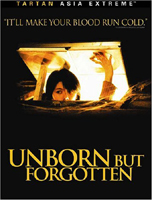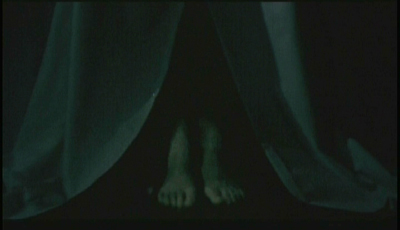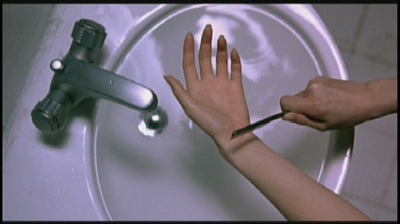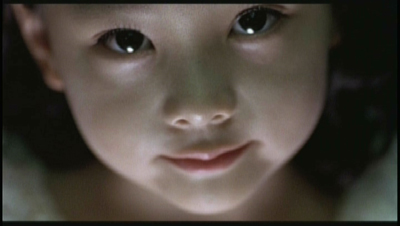 BUY IT AT AMAZON: CLICK HERE!
BUY IT AT AMAZON: CLICK HERE!
STUDIO: Tartan Video
MSRP: $24.99
RATED: R
RUNNING TIME: 90 Minutes
SPECIAL FEATURES:
• "On the Set" featurette
• Interviews with the two leads
• Original Korean Theatrical Trailer
• Photo Gallery
There is
a subset of horror that exploits the careless nature of fate. It has been
getting more popular lately, both in Asian and
simply for getting in the way of fate. The Ring took this approach,
destroying the lives of those random people who happened across the tape. It’s
a mode of fear very similar to that instilled by our nation’s driver’s
education teachers: even if you are the perfect driver, someone else can crash into you.
The Flick
Get this:
there’s this website, right? And it’s kind of a creepy website; it has a splash
page that’s kind of 2001-meets-CHUD’s color scheme. And when you look at this
website, okay, you die! Not right
away, of course; no you have seven days– sorry, fifteen days, and then you’re a goner. Funny thing is, men seem to
be immune to the effects of this sinister site (my pet theory is that viewing
porn for hours on end burns out critical evil-website-receptors in the brain).

SPOILER WARNING: Feet.
Yes, it’s
familiar to me, and familiar to you. Unborn But Forgotten‘s production
date is 2002, which places it post-Ringu, and the influence, even if
shared, is obvious. (Though an argument could be made that the story is more
similar to Fear.com than The Tragedy Of The Creepy Long-Haired Girl.) Our
plucky female reporter for this story is Su-jin Han, played by the
recently-deceased Eun-ju Lee. She is doing a story whose subject is Lee Seok
(Jeong Jun-ho), a cybercrimes investigator. Lee Seok is hot on the trail of the
owners of this deadly website (the whois service apparently not available in
plucky and all, decides not only to view the website, but also to move into the
apartment recently vacated by the last victim. You know, for research.
The first
two acts are overly concerned with the above exposition, as well as a subplot
which becomes important as the film goes on but is awkwardly-handled. The
intended sympathy for Han is created through a series of recycled methods,
which has the effect of distancing the audience rather than drawing them
closer. Instead of working as a slow burn, as Ju-On did, these first
two-thirds sputter and very nearly lose the flame entirely.
Part of
the blame for the uncomfortable speeches, for non-Korean speakers such as
myself, falls on the subtitling which oscillates between obvious and downright
awful. The correctly-spelled lines lack any subtlety, and feel as if the
babelfish approach was taken. The remaining lines are full of typos, omissions,
and improper punctuation. It’s a huge block for English-speaking viewers (I
can’t comment on the Spanish subtitles, being mono-lingual as I am), and one
that could have been removed by a careful proofreading.

"What the hell is a Graboid?"
The
dialogue is disconnected from the visuals, as a sad result, but that’s
sometimes all right, as one of the film’s strengths is in its creepy set-pieces
and supernatural scares. One of the trends in modern Asian cinema is to present
individual shots that are creepy in themselves, juxtaposed with the chronology
of the film. As with symbolic cuts (think of cutting to a rocket blasting off
as our heroes reach the climax of their lovemaking), this sort of editing
serves to underscore an emotion while, at the same time, screwing with the
audience’s involvement in the film. Usually, a viewer’s disbelief is suspended
well enough that his senses are open to being mangled by such cinematic
techniques. Often, that’s the case in Unborn But Forgotten, but I also
have to mention that there are a couple occasions of that trick pulled here
that do no more than break concentration as the viewer scrambles to figure out
how such a shot is justified within the film’s mythology.
The third
act goes a long way toward redeeming the whole film, with a set of reveals that
aren’t so much surprises as they are tragedies, made all the more tragic by
anticipation. The narrative becomes smoother, as well, as the subplots tie
together and the filmmakers can focus on a single thread. A gradual shift in
style accompanies the progress of the running time, as it becomes more clear
that whimsical fate is not the enemy.
In the
end, Unborn
But Forgotten breaks from the mold of fate-driven horror by attributing
all its tension to a societal ill. In theory, that sounds like a fine cooperation
of socially-conscious horror and modern scare tactics, but in practice the
marriage doesn’t work so well. Rather than peeling back the layers of skin on a
social problem, using horror as the knife, the film uses blunt tactics that end
up, surprisingly, more preachy than scary.
6 out of 10

I don’t think I need to say what she’s doing wrong, here.
The Look
Let it
not be said that Tartan Video slacks in their DVD transfers. This is a crystal
clear anamorphic widescreen treatment, with better-than-average black fidelity
and a surprising vibrancy in the colors. The impression you get from the
promotional artwork is that Unborn But Forgotten is a drab,
dreary film with a color palette consisting of Space Wolf Gray and Blood Red.
Not so; in fact, there is a noticeable method to the color placement employed
by the filmmakers to aid in the perception of mood for the different locations.
The
cinematography ain’t half bad, neither, with a number of tricky shots that hide
the creepy bits off-center, where the eye has to hunt them out. The visuals are
easily this disc’s best feature.
8.5 out of 10
The Noise
There are
no localized dubs for this film, but there are three different Korean-language
soundtracks. One is Dolby digital 2.0, one is Dolby digital 5.1, and the last
is that most elusive of creatures, the DTS 5.1. The first two are decent in
scope, but the DTS track blows them out of the water. This is a film with a
heavy focus on sound effects (creaking doors, foot steps, the clicking of a
doll’s eyeball) and every small touch comes through. I did notice some problems
in the sound editing, specifically effects that trailed over cuts when it
seemed they shouldn’t have.
It would
have been nice to get a dub, especially since the subtitles were, as mentioned
above, pretty lousy, but if it were a toss-up between the DTS track and the
dub, I’d pick the DTS, anyway.

All these worlds are yours…
8 out of 10
The Goodies
The
number of extras is directly proportional to the number of screens the film
played on, or something. Here we’ve got a couple promotional interviews with
the two leads, Jun-ho Jeong and Eun-ju Lee, which reek of publicist, as well as a similarly-minded behind-the-scenes featurette. Along with
those are the original Korean theatrical trailer and a production photo gallery.
But wait!
Because I’ve got space to fill, and I hate having single paragraph sections, I
will also tell you that there are subtitles, which come in both English and
Spanish flavors, and the Tartan Asia Extreme new release promotions.
4 out of 10

Stupid hospitals with their stupid corridors on a 6% grade.
The Artwork
The shot
chosen to feature on the cover isn’t particularly indicative of the plot or the
character. Like so many of the scares in the film, it’s simply there to offer a
bit of cheap tension. It’s nice, but I couldn’t help feeling that the point of
the film was "Unborn but forgotten in
the attic".
I do like
the slipcovers that the Tartan Asia Extreme films come with; they’re of a
thicker stock than most covers, and have a simple unified look that fits nicely
on a DVD shelf.
6 out of 10
Overall: 6.5 out of 10